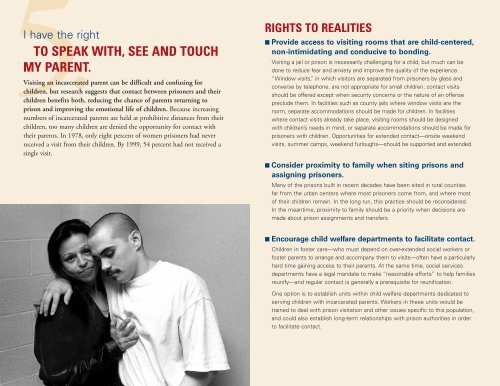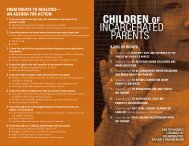Children-of-Incarcerated-Parents-Bill-of-Rights
Children-of-Incarcerated-Parents-Bill-of-Rights
Children-of-Incarcerated-Parents-Bill-of-Rights
You also want an ePaper? Increase the reach of your titles
YUMPU automatically turns print PDFs into web optimized ePapers that Google loves.
5.Visiting an incarcerated parent can be difficult and confusing forI have the rightTO SPEAK WITH, SEE AND TOUCHMY PARENT.children, but research suggests that contact between prisoners and theirchildren benefits both, reducing the chance <strong>of</strong> parents returning toprison and improving the emotional life <strong>of</strong> children. Because increasingnumbers <strong>of</strong> incarcerated parents are held at prohibitive distances from theirchildren, too many children are denied the opportunity for contact withtheir parents. In 1978, only eight percent <strong>of</strong> women prisoners had neverreceived a visit from their children. By 1999, 54 percent had not received asingle visit.RIGHTS TO REALITIES■ Provide access to visiting rooms that are child-centered,non-intimidating and conducive to bonding.Visiting a jail or prison is necessarily challenging for a child, but much can bedone to reduce fear and anxiety and improve the quality <strong>of</strong> the experience.“Window visits,” in which visitors are separated from prisoners by glass andconverse by telephone, are not appropriate for small children; contact visitsshould be <strong>of</strong>fered except when security concerns or the nature <strong>of</strong> an <strong>of</strong>fensepreclude them. In facilities such as county jails where window visits are thenorm, separate accommodations should be made for children. In facilitieswhere contact visits already take place, visiting rooms should be designedwith children’s needs in mind, or separate accommodations should be made forprisoners with children. Opportunities for extended contact—onsite weekendvisits, summer camps, weekend furloughs—should be supported and extended.■ Consider proximity to family when siting prisons andassigning prisoners.Many <strong>of</strong> the prisons built in recent decades have been sited in rural countiesfar from the urban centers where most prisoners come from, and where most<strong>of</strong> their children remain. In the long run, this practice should be reconsidered.In the meantime, proximity to family should be a priority when decisions aremade about prison assignments and transfers.■ Encourage child welfare departments to facilitate contact.<strong>Children</strong> in foster care—who must depend on over-extended social workers orfoster parents to arrange and accompany them to visits—<strong>of</strong>ten have a particularlyhard time gaining access to their parents. At the same time, social servicesdepartments have a legal mandate to make “reasonable efforts” to help familiesreunify—and regular contact is generally a prerequisite for reunification.One option is to establish units within child welfare departments dedicated toserving children with incarcerated parents. Workers in these units would betrained to deal with prison visitation and other issues specific to this population,and could also establish long-term relationships with prison authorities in orderto facilitate contact.



